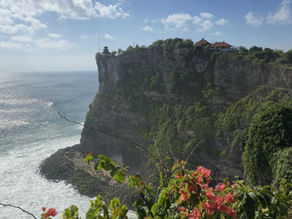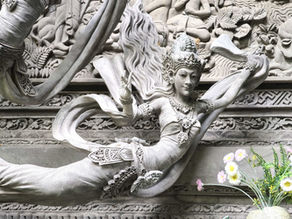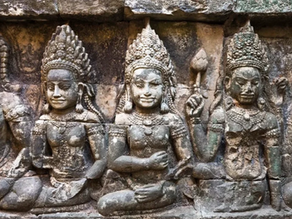top of page

GLOBAL SHANANIGANS

Search


Bedogol - The Gatekeepers
Across Bali, Bedogol refers to the guardian statues that flank the entrances of temples and family compounds, the silent watchers carved in stone. Positioned in pairs on either side of a gateway, they serve as spiritual protectors, anchoring the threshold between the ordinary world and sacred ground.
Shannon


Puri Langon Temple
Puri Langon is a privately owned royal compound located in central Ubud. It is the personal residence of Tjokorda Ngurah Suyadnya, better known as Cok Wah, a respected figure in the Ubud royal family. Though it remains a functioning private home, Puri Langon is open to the public free of charge, offering rare access to a lived-in royal space that continues to serve spiritual and cultural functions within the community.
Shannon


Hanoi Old Quarter
A living, breathing time capsule, Hà Nội Old Quarter is a tapestry woven from centuries of colonial exploitation, Confucian rituals, dynastic collapses and wartime destruction. Despite relentless modernisation and gentrification, the Old Quarter remains defiantly alive. It preserves not just Hà Nội’s heritage but the very essence of Vietnam’s ability to adapt and endure.
Shannon


Batara Kala - Devourer of Time and Light
Batara Kala, in Balinese mythology, is the monstrous deity of time, destruction and the underworld. He's a god born not from light but from the uncontrolled lust of the supreme god Shiva (Siwa). In one chilling version of his origin, Batara Kala is conceived during a moment of cosmic imbalance, when Shiva’s spilled seed, filled with uncontrollable rage and passion, falls to earth and takes form.
Shannon


Thailand's Golden Triangle
The Golden Triangle snakes along the borders of Thailand, Laos and Myanmar, a land as beautiful as it is brutal. The Mekong River twists like a silver serpent through shadowed valleys, past isolated villages whose fields once fed a global hunger for heroin. This rugged, turbulent region earned its infamous name from centuries of opium fueled violence and despair. More than a crossroads, the Golden Triangle is a nexus of greed, pain and heartbreak.
Shannon


Beyond the Mist - Exploring Sapa
Tucked high in the Hoàng Liên Son Mountains of northwestern Vietnam, Sapa’s history predates the modern tourism boom by centuries. Archaeological discoveries suggest that humans have inhabited this rugged region for thousands of years. Stone tools, ceramic fragments and burial items uncovered in the Muong Hoa Valley point to a Neolithic culture that once thrived along the riverbanks. These finds, some dating back 3000 years, are among the earliest signs of life in Vietnam’s m
Shannon


Inside the Puputan - Bali's Bloody Resistance
The Dutch first reached Bali in 1597 while scouting new ground for conquest and profit. They left without drawing blood but they didn’t leave without a decision. Bali had been marked. For the next two centuries, the island remained untouched, not because the Dutch had lost interest, but because they were waiting for the moment it would be worth the slaughter. It wasn’t peace. It was a pause before an extermination. When they returned, the rivers would turn red.
Shannon


Ho Chi Minh Museum
The Ho Chi Minh Museum in Hanoi is more than a museum, it is a shrine to revolution, memory and sacrifice, standing as one of Vietnam’s most important monuments. It honours the man known as “Uncle Ho” while also serving as a vast archive of the struggles that shaped modern Vietnam, a place where personal biography and national trauma merge into a single, powerful narrative.
Shannon


Uluwatu Temple
Overlooking the vast and turbulent Indian Ocean on Bali’s Bukit Peninsula, Uluwatu Temple (or Pura Luhur Uluwatu) perches 70 metres above the waves, a landmark of both awe and solemnity. Archaeological evidence shows its origins date back to the 9th century, based on an ancient split gateway bearing a chronogram marking 886 .AD, confirming its megalithic roots as one of the island’s oldest sacred sites
Shannon


Bhoma - Bali's Protector and Judge
In the architectural language of Balinese temples, Bhoma statues are not merely decorative but play a protective and symbolic role. Bhoma is derived from the ancient Sanskrit word bhūma, meaning “Earth” and is considered a guardian spirit linked to fertility, the forest and subterranean realms. Usually mounted above temple gates or embedded within sacred water features, these fierce, leaf entwined figures serve as guardians of spiritual boundaries,
Shannon


Ganesh - The Remover of Obstacles
In the moss veiled temples of Bali, Ganesha is far more than a familiar Hindu icon, he is a living force who moves between light and shadow. Though his roots lie in Indian Hinduism, Bali’s Ganesha (also known as Batara Gana) has taken on new dimensions, shaped by animist spirits, local rituals and the Balinese understanding of cosmic balance.
Shannon


Taman Dedari - Dine Among the Divine
Born from the legend of Resi Markandeya’s vision of angelic dancers over the Ayung River, Taman Dedari blends myth and appetite in equal measure. Here, guests savour Balinese flavours in a riverside setting guarded by monumental stone Dedari, the celestial maidens of old.
Shannon


Taman Ujung Water Palace
In the heart of Batuan village stands one of Bali’s oldest and most spiritually charged temples: Pura Puseh Desa Batuan. Founded in 1020 AD, it’s recorded in Balinese historical texts that stretch back over a millennium. Its structure is not only physically resilient but symbolically rooted in something far older, believed to have been built atop a megalithic worship site once used for ancestral rites.
Shannon


Gateway to Bali - The Soul of Tuban
Long before it became a quiet suburb near Kuta, Tuban was a vital coastal hub within the ancient Kingdom of Badung, linking Bali to the wider archipelago through maritime trade. Its name, drawn from the sound of retreating waves, reflects a deeper spiritual rhythm, one that still echoes through Balinese belief in the cycles of life, death and rebirth.
Shannon


Keramas Black Sand Surf Beach
Keramas Beach, located on Bali’s less developed eastern coastline in Gianyar, is known for its striking black volcanic sand and powerful surf breaks. Unlike the bustling beaches of Kuta or Seminyak, Keramas maintains a more secluded atmosphere, drawing a niche crowd of surfers rather than general tourists.
Shannon


Hiroshima Castle - Echoes of an Empire
Rising from the flatlands of western Japan, Hiroshima Castle was a powerful nerve centre built by Mōri Terumoto during an age of shifting allegiances and ruthless ambition. With its broad moat and imposing stone walls, the castle was less about isolation and more about control, a symbol of calculated authority in a time of near constant war.
Shannon


Meijiawu Tea Village - Tea of the Emperors
Tucked into the misty hills near Hangzhou’s famous West Lake, Meijiawu is more than just a tea village, it’s a living testament to China’s centuries old relationship with tea. The name "Meijiawu" translates to "The Village of the Mei Family," pointing to a 600-year lineage of hand cultivating tea that began with the Mei clan and continues to thrive today. Over time, this small village grew into a national symbol, with its identity and prosperity deeply intertwined with tea cu
Shannon


The Birth of Apsaras - Daughters of the Ocean of Milk
Apsaras, the celestial nymphs of Hindu and Buddhist mythology, are revered for their unparalleled beauty, graceful movements and mastery of dance and music. Adorned with golden skin, fragrant hair and flowing garments, they appear throughout ancient texts as divine attendants in the heavenly courts of gods like Indra, where they serve as entertainers and symbols of spiritual and aesthetic refinement.
Shannon


Bailong Elevator - In the Shadow of Dragons
Rising like a gleaming spine along the raw sandstone cliffs of Zhangjiajie National Forest Park in China’s Hunan Province, the Bailong Elevator, also known as the "Hundred Dragons Elevator" is both a marvel of modern engineering and a looming monolith that stirs ancient fears. Piercing 326 metres into the sky, it is the tallest outdoor elevator in the world.
Shannon


Hoàn Kiếm Sword Lake and the Turtle Tower
Nestled in Hanoi’s bustling Old Quarter, Hoàn Kiếm Lake offers a serene escape from the city's chaos. This natural freshwater lake, stretching 700 metres across 12 hectares, has been a cultural and historical anchor for centuries, its origins possibly predating Hanoi itself by over a thousand years.
Shannon
bottom of page